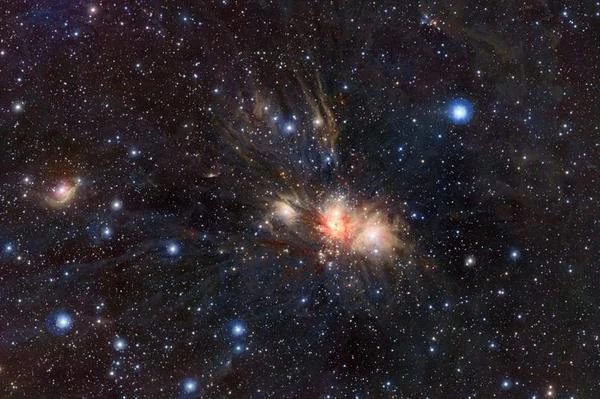
The NGC 2170 is a magnificent nebula located in the Monoceros constellation, about 2,400 light-years away from us. It blends several types of clouds: blue areas where the light of young stars is scattered, red glowing regions due to hot gas, and dark bands of thick dust that partially obscure the light. This colorful and complex ensemble is caused by the way dust grains in the Mon R2 cloud absorb and scatter light.
NGC 2170 is part of a large cloud filled with molecular hydrogen (H2) and interstellar dust, composed of silicates and carbon. This dust captures the ultraviolet light from young, massive stars and re-emits it as infrared light, invisible to the naked eye. Thanks to observations from the Herschel satellite, several ionized gas zones and jets from young stars have been detected, indicating ongoing star formation.
The colors of NGC 2170 are explained by different phenomena: the blue comes from the light of young stars scattered by very small dust grains, while the red comes from hot gas emitting its own light. The dark areas correspond to concentrations of dust that block visible light but glow in the infrared, revealing the heat they contain.
Light scattering depends on wavelength: the bluer the light, the more it is scattered, which is why blue dominates in reflection nebulae. This light-dust interaction also helps astronomers better understand the size and distribution of dust grains in the cloud.
NGC 2170 is a true stellar nursery. In this region, many protostars have been detected using the Spitzer space telescope and the ALMA network. These young stars, still surrounded by disks of matter that could form planets, send powerful jets of matter in opposite directions, sculpting the cloud around them. The gas in the region is very cold, around 25 K (-248 °C), and quite dense, with about 10,000 particles per cubic centimeter.
These conditions favor the growth of stars and the fragmentation of the cloud into several dense regions, a process studied by Edwin Salpeter (1924-2008) to understand how stellar masses are distributed at birth.
By observing the light emitted by NGC 2170, astronomers detect signatures of molecules such as CO, NH₃, or CH₃OH, showing that chemistry is very active there. The infrared light captured by the Spitzer telescope allows identifying areas where the gas is heated and locating star-forming cores. Using computer models, it is possible to reconstruct the 3D shape of the cloud and estimate its total mass at about 3,000 times the mass of the Sun.
N.B.:
In a reflection nebula like NGC 2170, the dust temperature remains low (\(T < 30\,K\)), meaning most of its radiation is in the far infrared.
| Parameter | Estimated Value | Observation Method | Comment |
|---|---|---|---|
| Distance | ≈ 2,400 ly | Infrared photometry | Based on the luminosity of associated stars |
| Average temperature | ≈ 25 K | IR continuum measurement (Herschel) | Cold and dense region |
| Average density | 104 cm-3 | Millimeter spectroscopy (CO) | Dense molecular gas |
| Estimated age | < 2 million years | Dating of young stars | Region still forming |
| Total mass | ≈ 3,000 M☉ | Infrared flux modeling | Includes dust and molecular gas |